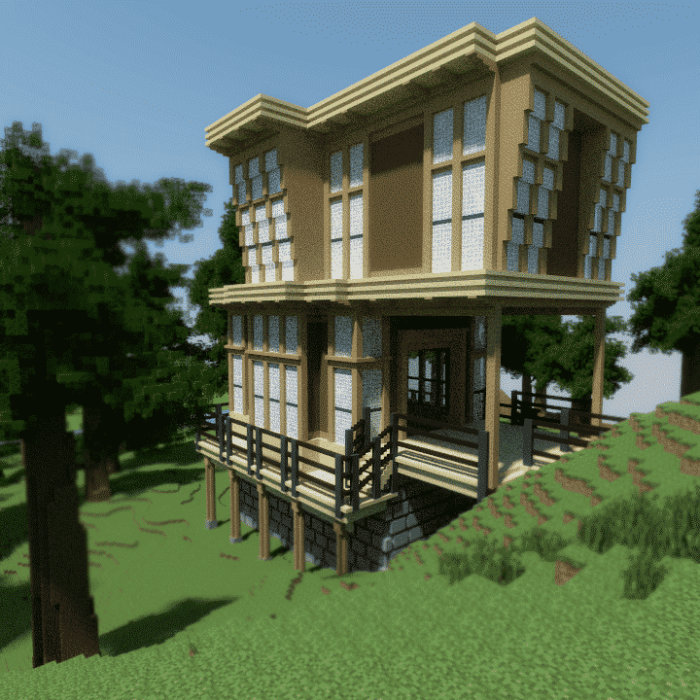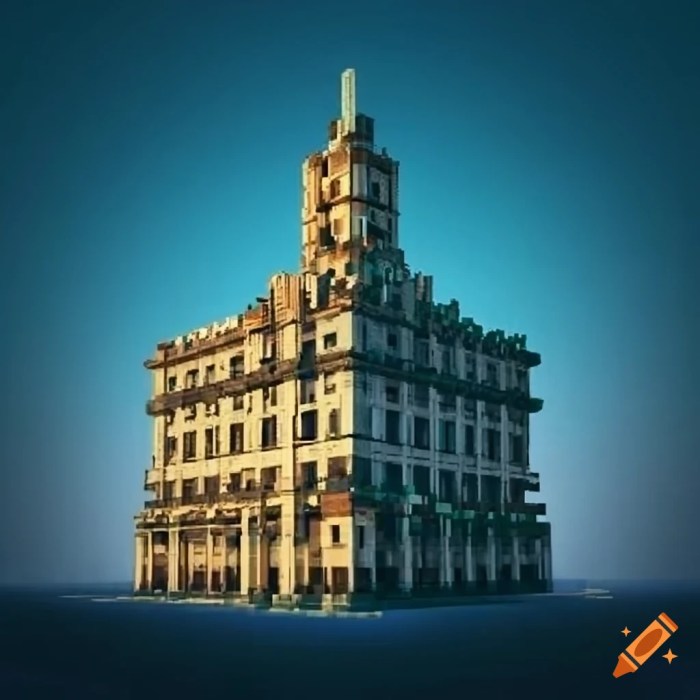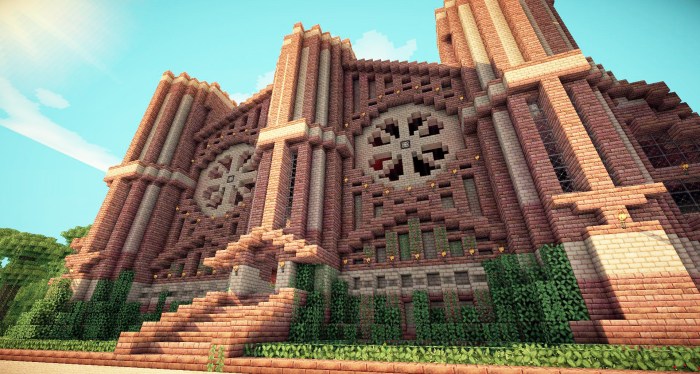Architectural Styles in 3D Minecraft: Ideas and Inspirations – It’s not just about building houses, it’s about crafting worlds. Minecraft, with its pixelated blocks and limitless possibilities, has become a canvas for architectural expression, where players can recreate historical masterpieces or invent entirely new styles.
From towering castles to futuristic skyscrapers, the game allows you to explore the depths of your creativity and bring your architectural dreams to life.
This guide delves into the world of Minecraft architecture, exploring classic styles like medieval castles and Gothic cathedrals, as well as the unique, “Minecraft-specific” designs that have emerged from the game’s community. We’ll look at how builders adapt traditional architectural elements to the blocky world of Minecraft, and provide inspiration and resources for those looking to take their building skills to the next level.
Introduction to Minecraft Architectural Styles

Minecraft, the wildly popular sandbox game, has captured the imaginations of millions with its endless possibilities. It’s not just about building blocks; it’s about unleashing your creativity and transforming your wildest architectural dreams into tangible structures. The game’s simple yet powerful mechanics offer a unique creative freedom, allowing players to build anything they can imagine, from humble cottages to sprawling castles.
Popular Minecraft Architectural Styles
Minecraft’s diverse community has created a rich tapestry of architectural styles, each reflecting the player’s preferences and inspirations. Some of the most popular styles include:
- Medieval:This timeless style is characterized by its grand castles, towering cathedrals, and quaint villages. Players often incorporate elements like stone walls, pointed arches, and stained glass windows to capture the essence of medieval architecture.
- Modern:This style emphasizes clean lines, geometric shapes, and minimalist design. Players often utilize glass, concrete, and steel to create sleek and futuristic structures. The modern aesthetic can be seen in everything from sleek skyscrapers to minimalist homes.
- Japanese:This style is inspired by traditional Japanese architecture, featuring intricate details, natural materials, and a strong connection to nature. Players often incorporate elements like wooden beams, tatami mats, and Zen gardens to create a serene and tranquil atmosphere.
- Fantasy:Minecraft’s creative freedom allows players to push the boundaries of reality and build structures inspired by fantasy worlds. These builds often feature whimsical designs, mythical creatures, and magical elements. Players may incorporate elements like dragons, floating islands, and enchanted forests.
Exploring Classic Architectural Styles: Architectural Styles In 3D Minecraft: Ideas And Inspirations
Minecraft, with its blocky aesthetic and vast creative possibilities, provides an ideal platform for exploring various architectural styles. From the grandeur of medieval castles to the elegance of Renaissance palaces, classic architectural styles can be brought to life within the Minecraft world.
Medieval Castles
Medieval castles, with their imposing structures and defensive fortifications, are a popular choice for Minecraft builders. These structures, often featuring towering walls, drawbridges, and fortified towers, capture the essence of medieval warfare and architecture.
- The use of stone blocks, often in a rough-hewn style, creates a realistic representation of medieval masonry.
- The incorporation of defensive features such as moats, arrow slits, and portcullises adds to the authenticity of the castle design.
- The inclusion of detailed interiors, with throne rooms, armories, and dungeons, further enhances the immersive experience.
Gothic Cathedrals
Gothic cathedrals, known for their soaring arches, stained glass windows, and intricate details, pose a unique challenge for Minecraft builders. The intricate details of Gothic architecture can be faithfully recreated using a combination of blocks, textures, and custom designs.
- The pointed arches, a defining feature of Gothic architecture, can be constructed using custom designs and block combinations.
- Stained glass windows, with their vibrant colors and intricate patterns, can be recreated using stained glass blocks and custom designs.
- The use of different colored blocks and textures can capture the intricate details of Gothic carvings and ornamentation.
Renaissance Architecture
Renaissance architecture, with its emphasis on symmetry, balance, and classical elements, can be effectively implemented in Minecraft. The use of classical orders, such as the Doric, Ionic, and Corinthian, can add a touch of grandeur and sophistication to Minecraft builds.
- The use of smooth stone blocks and custom designs can recreate the smooth, polished surfaces characteristic of Renaissance architecture.
- The incorporation of classical elements, such as columns, arches, and domes, adds a sense of elegance and refinement.
- The use of symmetry and balance in the design creates a sense of harmony and order.
Modern Architecture
Modern architecture, with its emphasis on functionality, simplicity, and innovative materials, can be surprisingly well-suited to the Minecraft environment. The use of glass blocks, concrete, and other modern materials can create striking and contemporary structures.
- The use of glass blocks allows for the creation of open, airy spaces that are characteristic of modern architecture.
- The incorporation of geometric shapes and clean lines creates a sense of order and simplicity.
- The use of concrete blocks and custom designs can replicate the smooth, monolithic surfaces often found in modern buildings.
Minecraft-Specific Styles and Techniques

Minecraft’s open-ended nature and unique block-based construction have fostered the development of architectural styles that are distinctly different from traditional styles. These styles are not mere imitations of real-world designs but rather unique expressions born from the limitations and possibilities of the Minecraft world.
Minecraft-Specific Design Elements
The unique characteristics of Minecraft’s building blocks and game mechanics have led to the emergence of architectural elements that are distinct from traditional styles. These elements are not merely decorative but often serve practical purposes within the game’s environment.
- Blocky Aesthetics:Minecraft’s inherent blockiness is embraced rather than disguised. This results in bold, geometric structures with sharp angles and minimal curves. The use of different block types creates unique textures and patterns, adding depth and visual interest to the structures.
- Layered Construction:The game’s mechanics encourage the use of layering to create complex structures. This involves stacking blocks horizontally and vertically to achieve a sense of depth and dimension. Layering can be seen in the construction of walls, roofs, and even intricate details like windows and doors.
- Functional Design:Minecraft’s emphasis on functionality leads to the creation of structures that serve specific purposes. For example, buildings often incorporate features like farms, storage rooms, and defensive elements. These features are not merely aesthetic but essential for survival and gameplay.
- Resource-Driven Design:The availability of specific materials influences the design of structures. Builders often incorporate readily available resources, such as wood, stone, and iron, into their designs. This results in a sense of resourcefulness and adaptability, reflecting the challenges of resource management within the game.
- Redstone Integration:Redstone, the game’s electrical system, enables the creation of intricate mechanisms and automated systems. Redstone circuits can be integrated into buildings, adding functionality and complexity to structures. This element allows for the creation of moving parts, lighting effects, and even functional machines.
Comparing Traditional and Minecraft-Specific Architectural Elements
Here is a table comparing traditional architectural elements with their Minecraft-specific counterparts:
| Traditional Architectural Element | Minecraft-Specific Architectural Element |
|---|---|
| Arch | Block-based Arch (often constructed with stair blocks) |
| Column | Block-based Pillar (using blocks or slabs) |
| Window | Glass Block Window (often with decorative frames) |
| Roof | Layered Roof (using different block types for texture) |
| Door | Block-based Door (with various designs and materials) |
| Staircase | Stair Block Staircase (with different designs and materials) |
Inspiration and Resources for Minecraft Builders

Minecraft architecture is a vast and creative realm, filled with possibilities limited only by imagination. But where do you find the inspiration to embark on your own architectural journey? The answer lies in the vibrant community of Minecraft builders, the wealth of online resources, and the timeless influence of real-world architecture.
From medieval castles to futuristic skyscrapers, Minecraft’s architectural possibilities are boundless. To truly master these styles, though, you need to understand the fundamental principles of 3D design, which is where 3D Minecraft Building and Design comes in. This resource equips you with the skills to bring your architectural dreams to life, whether it’s a quaint cottage or a sprawling city.
This section delves into the world of inspiration and resources available to Minecraft builders, highlighting influential creators, helpful tools, and dedicated communities.
Influential Minecraft Builders
Minecraft’s architectural landscape is shaped by a diverse range of builders, each bringing unique styles and techniques to the game. Their creations inspire awe, ignite creativity, and serve as a valuable learning resource for aspiring architects.
- Grian: Known for his intricate builds and comedic personality, Grian is a popular Minecraft YouTuber whose creations range from whimsical castles to sprawling cities. He demonstrates innovative building techniques and offers a lighthearted approach to Minecraft architecture.
- Mumbo Jumbo: This builder focuses on complex redstone contraptions, showcasing impressive engineering skills and intricate mechanisms. Mumbo Jumbo’s creations are a testament to the technical aspects of Minecraft architecture, offering insights into complex design and functionality.
- The Mythical Sausage: This builder’s work is known for its meticulous detail and realistic depictions of real-world architecture. The Mythical Sausage’s builds often incorporate intricate landscaping and landscaping techniques, creating immersive and visually stunning environments.
Online Resources and Communities
The internet is a treasure trove of inspiration and resources for Minecraft builders. Dedicated websites, forums, and communities offer a platform for sharing ideas, showcasing builds, and learning from others.
- Planet Minecraft: This website acts as a central hub for Minecraft builders, offering a vast library of blueprints, tutorials, and community projects. It’s a platform for sharing creations, finding inspiration, and connecting with other builders.
- Minecraft Forums: These forums provide a space for discussion, troubleshooting, and sharing knowledge. Builders can seek advice, collaborate on projects, and learn from experienced members of the community.
- Reddit’s r/Minecraft: This subreddit is a vibrant community dedicated to all things Minecraft, including architecture. It’s a place to share builds, discuss techniques, and find inspiration from other builders.
Tools and Resources for Minecraft Building
Beyond inspiration, Minecraft builders rely on various tools and resources to enhance their building process and achieve their architectural visions.
- WorldEdit: This powerful plugin allows for efficient manipulation of blocks, creating and modifying structures with ease. It simplifies large-scale projects and facilitates complex designs.
- VoxelSniper: Similar to WorldEdit, VoxelSniper offers precise control over block placement, enabling detailed sculpting and intricate designs. It’s a valuable tool for creating unique and intricate architectural elements.
- MCEdit: This external program allows for editing Minecraft worlds outside the game, offering a visual interface for manipulating terrain, structures, and blocks. It’s a useful tool for planning and designing complex builds.
The Future of Minecraft Architecture
Minecraft architecture is a constantly evolving art form, shaped by the creativity of its players and the continuous updates to the game. As new blocks, features, and mechanics are introduced, builders push the boundaries of what’s possible, leading to innovative and stunning creations.
Potential Evolution of Minecraft Architectural Styles, Architectural Styles in 3D Minecraft: Ideas and Inspirations
The future of Minecraft architecture holds exciting possibilities, driven by advancements in technology, the game itself, and the ingenuity of its players. Here are some potential trends:* Integration of New Mechanics:The introduction of new mechanics like redstone, command blocks, and data packs has already revolutionized Minecraft building.
Future updates could introduce even more advanced features, allowing for dynamic structures, interactive elements, and complex systems that blur the line between building and programming. Imagine buildings that change color based on the time of day, or structures that react to player interaction.
Enhanced Realism and Detail
Minecraft’s blocky aesthetic is part of its charm, but the addition of more detailed blocks, textures, and lighting effects could significantly enhance the realism of structures. This could lead to the creation of hyper-realistic buildings that rival the detail of real-world architecture.
Exploration of New Building Materials
The introduction of new blocks, such as the “Sculk” blocks in the recent “The Deep Dark” update, offers builders new possibilities for creating unique and visually appealing structures. Future updates could introduce even more diverse materials, each with its own unique properties and aesthetics.
Hypothetical Minecraft City Showcasing Future Trends
Imagine a futuristic Minecraft city called “Nova,” designed to showcase the potential of future architectural trends. * Dynamic Structures:Buildings in Nova could incorporate dynamic elements like retractable roofs, changing facades, and even moving sections. These features could be controlled by redstone circuits or data packs, creating a constantly evolving cityscape.
Integration of Technology
Nova could feature advanced technology, such as holographic displays, automated transportation systems, and even integrated farms that produce food using advanced hydroponics. These technologies could be implemented using redstone, command blocks, and data packs.
Sustainable Design
Nova could be a model of sustainable living, incorporating features like renewable energy sources, vertical gardens, and water recycling systems. These elements could be implemented using blocks like solar panels, bamboo, and water filters.
Vision for the Future of Minecraft Building
The future of Minecraft building is incredibly exciting. As the game evolves, builders will have access to more powerful tools and resources, allowing them to create even more impressive and innovative structures. The potential for creativity and expression is truly limitless.
Epilogue
Minecraft architecture is a constantly evolving art form, fueled by the imagination of its players. Whether you’re a seasoned builder or just starting out, the possibilities are endless. From recreating iconic structures to designing your own unique masterpieces, Minecraft offers a platform for architectural exploration and creative expression.
So grab your pickaxe, unleash your inner architect, and start building!